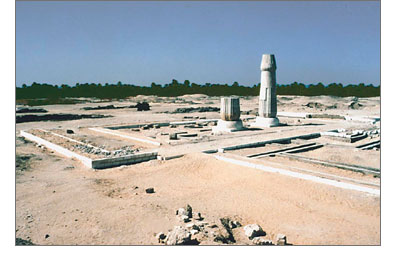The City of Akhet-Aten
|
Restored Small Aten Temple at el Amarna |
|
Akhet-Aten (view map) was built very quickly, using sun-dried mud brick rather than stone in most capacities. The archaeologists often comment in their reports about the shabby construction work hidden beneath the white-washed and often painted walls of the city buildings. The city was demolished and defaced by the Egyptians after Akhenaten's reign ended. For these reasons little remains of the site today, even though it was occupied for only a decade or two. However, from aerial photos you can still clearly read the lines of the walls of buildings. Currently teams are working under the direction of Barry Kemp of the EES in Amarna, reconstructing and studying the ruins. Though Akhet-Aten was occupied for only a handful of years by the Egyptians, there have also been monastic settlements and roman camps, and part of the site is still unexcavated beneath modern cultivation closer to the nile. Akhenaten choose to move there in his fourth year as Pharaoh, soon carving beautiful boundary stelae into the cliffs around the city, attributing the choice of the site to the Aten. Many of these stelae have since been destroyed, in at least one case by treasure-seekers trying to open the "door" in the stone. The city itself is divided into suburbs, with the so-called "central city" housing the Royal Palace and The Great Temple (The Per-Aten), as well as various buildings archaeologists have labelled official (police, taxes...). It is here in one such building, the 'records office' that the Amarna Letters were found by a peasant woman. Further south, the famous bust of Nefertiti was discovered in Thutmose's workshop at Akhet-Aten. To the east there is an interesting settlement dubbed "the workmen's village" - it is a walled enclosure of very regular houses along several parallel streets. Archaeologists believed it housed workers working on the rock tombs nearby (which, incidentally, though built for the royalty and courtiers, were never occupied). However, this walled town had a guard house at the only exit, and it seems more likely to have been to keep the workers in than anything out (the main city was protected by no such wall, for the whole site, including the workmen's village, is enclosed by high cliffs). Elsewhere the city has grown up as cities are wont; in an irregular haphazard way, as citizens erected buildings where they felt it was convenient. Some suggst Akhenaten lacked the resources to control the rapid growth of his new city and regulate its plan (other Egyptian cities are much more carefully laid out). The archaeological history of the site is fascinating. As one reads the archaelogical reports, one comes across the various excavators fiercely critisizing each other's methods, and it seems they knew little of each other's activities. The British, at one point, wonder on a heap of badly excavated rubble, the creator of which no one can decide. The Germans sneak the Bust of Nefertiti back to Germany under the noses of the British by a clever ruse (they hid it with the pot sherds and garbage that they were allowed to take for themselves). Poor Petrie conserved a beautiful floor fresco in the palace by applying a laquer to the entire floor with the side of one finger, hoping not to damage it, only to have it hacked to bits by an angry local. Further information:
|
![]()
|
|
This page is part of The
Akhet-Aten Home Page |

